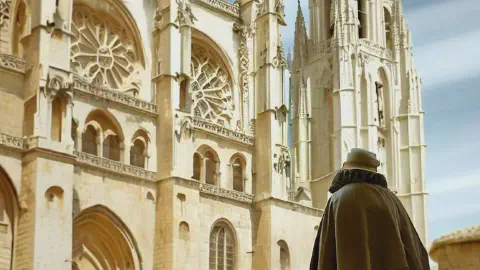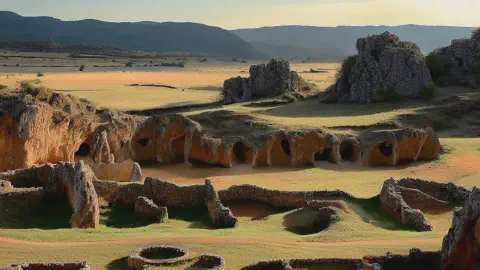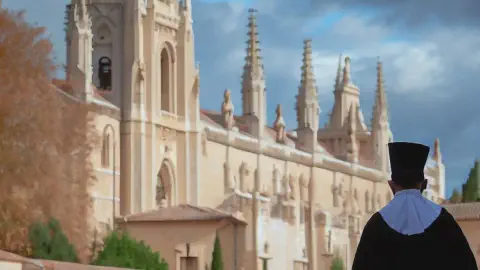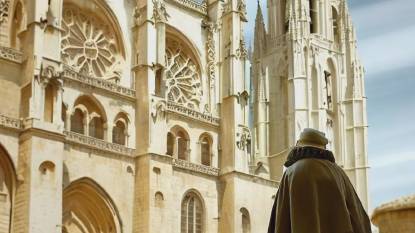
Camino Francés: San Juan de Ortega to Burgos Stage 12
Posted: | Updated:
Reading time: 10 minutes
Camino Francés: San Juan de Ortega to Burgos Stage 12
Posted: | Updated:
Reading time: 10 minutes
By: Simon Kemp , Editor
This section of your Camino Francés pilgrimage is about 27 kilometers (roughly 17 miles) long. The journey begins in the tranquil sanctuary of San Juan de Ortega. The stage is filled with a mix of forest trails, rural landscapes, and finally, the urban setting of Burgos.
The Camino Francés continues its journey from San Juan de Ortega, a remote monastic settlement founded to aid pilgrims, to Burgos, a city renowned for its medieval grandeur. This stage presents a varied landscape, transitioning from wooded trails to open plains before reaching the urban heart of Castilla y León.
Historical Background
- San Juan de Ortega: Named after Saint John the Hermit, this hamlet was established in the 12th century as a refuge for pilgrims crossing the treacherous Montes de Oca. The monastery, built by the saint himself, remains a key stop on the Camino, offering shelter and a place for reflection. A unique architectural feature of the monastery is the Annunciation capital, which is illuminated by sunlight on the spring and autumn equinoxes, a phenomenon that has fascinated visitors for centuries.
- Burgos: Founded in 884 AD as a defensive stronghold, Burgos became a major medieval center of trade and pilgrimage. It is home to the Burgos Cathedral, a UNESCO World Heritage Site, celebrated for its Gothic architecture and intricate sculptures. The city also played a pivotal role in Spanish history, serving as the capital of Castilla for centuries and as the final resting place of El Cid, Spain’s legendary warrior.
The Camino Route
The journey from San Juan de Ortega to Burgos spans approximately 27 km and is characterized by:
- A gentle descent from the monastery into the village of Agés, where pilgrims encounter traditional stone houses and a small but well-preserved church.
- A gradual climb to Atapuerca, a site of immense archaeological importance, where fossils of the earliest known hominids in Europe were discovered.
- A rugged stretch over the Sierra de Atapuerca, offering panoramic views before descending into the plains.
- A choice of routes approaching Burgos—pilgrims can follow the traditional path through industrial outskirts or opt for the river route, which winds along the Arlanzón River, providing a more scenic entrance into the city.
- Arrival at Burgos, where the Arco de Santa María, a grand medieval gateway, marks the entrance to the historic center.
This stage is considered moderately challenging, with a mix of forest trails, archaeological sites, and urban landscapes. Pilgrims often find it to be one of the most historically rich sections of the Camino, offering a deep connection to Spain’s medieval past.
Map of San Juan de Ortega to Burgos Route
Route Description
A. Detailed Breakdown of the Route
- San Juan de Ortega to Agés (3.5 km) Start your morning in San Juan de Ortega, a small hamlet named after a local saint. The first part of this stage is an easy stroll to Agés, a charming village with a small but beautifully preserved church.
- Agés to Atapuerca (3 km) The walk from Agés to Atapuerca passes through gentle hills and farmland. Atapuerca is renowned for its archaeological sites, where fossils of the earliest known hominids in Europe were discovered.
- Atapuerca to Cardeñuela Riopico (6.5 km) This stretch offers a climb to the Sierra de Atapuerca, followed by a descent into the village of Cardeñuela Riopico. The scenery is dotted with wheat fields and panoramic views.
- Cardeñuela Riopico to Burgos (14 km) The final stretch to Burgos begins with rural scenery that gradually transitions into suburban and then urban landscapes. Look forward to Burgos’ magnificent Gothic Cathedral, a UNESCO World Heritage Site.
B. Terrain and Elevation
The terrain on this stage is quite varied. You will have noticed on the previous leg from Belorado to San Juan de Ortega, that the landscape started to change. Now you will encounter mostly dirt paths and some paved country roads. The highest elevation is at the Sierra de Atapuerca, after which the terrain gradually descends towards Burgos.
C. Points of Interest
- Church of San Juan de Ortega: Start your day at this peaceful 12th-century church dedicated to the saint who devoted his life to improving the Camino.
- Atapuerca archaeological sites: Visit the place where the oldest human fossils in Europe were discovered, with a museum showcasing the significant findings.
- Burgos Cathedral: End your day in Burgos, home to one of Spain’s most stunning Gothic cathedrals.

D. Potential Challenges
The main challenge on this stage is the climb up to the Sierra de Atapuerca. The path is steep but well-maintained, and the views from the top are well worth the effort.
E. Rest Stops
There are several towns and villages along this stage where you can rest, refill your water bottle, or grab a bite to eat. These include Agés, Atapuerca, and Cardeñuela Riopico. Once you reach Burgos, there are numerous cafes, restaurants, and bars to choose from. Enjoy your walk and buen camino!
Departure Point: San Juan de Ortega
San Juan de Ortega, situated in the breathtaking landscapes of northern Spain, invites you to embark on a journey that intertwines history, spirituality, and natural splendor.
Location and History
Located in the province of Burgos, San Juan de Ortega enchants visitors with its serene setting along the revered Camino de Santiago pilgrimage route. The town derives its name from the venerated medieval figure, San Juan de Ortega, who played a pivotal role in the development of the famous pilgrimage. Pilgrims have treaded upon its ancient paths for centuries, seeking solace and enlightenment.
San Juan de Ortega’s history dates back to the 12th century when the saint, renowned for his architectural prowess, erected the magnificent Iglesia de San Juan de Ortega. This Romanesque marvel stands as a testament to the town’s rich heritage, showcasing architectural details that have withstood the test of time. Pilgrims from far and wide pause here to pay homage and find solace within its hallowed walls.
Points of Interest
San Juan de Ortega boasts captivating points of interest that illuminate its historical and spiritual significance. The Iglesia de San Juan de Ortega, with its imposing stone facade and graceful archways, beckons visitors to explore its sacred interior adorned with intricate artwork and religious symbolism. The subdued lighting and tranquil ambience create a serene space for contemplation and introspection.
Adjacent to the church, the Monastery of San Juan de Ortega stands as a sanctuary of respite for pilgrims. Originally constructed to provide shelter to weary travelers, the monastery continues to offer a haven for those traversing the Camino de Santiago. Its serene cloister and peaceful courtyard provide pilgrims with an opportunity to reflect and rejuvenate their spirits.
Pilgrim Hospitality
As a pivotal stop on the Camino de Santiago, San Juan de Ortega extends its warm hospitality to weary pilgrims. The town provides essential services, including comfortable albergues (hostels), where pilgrims can find rest and replenish their energy. The sense of community and camaraderie among fellow travelers fosters connections and shared experiences that enrich the pilgrimage journey.
The local community in San Juan de Ortega embraces pilgrims with open arms, offering assistance, guidance, and heartfelt hospitality. Volunteers and residents provide support, ensuring that pilgrims feel welcomed and cared for during their stay. The spirit of generosity and compassion resonates throughout the town, creating a supportive and uplifting atmosphere.
Natural Beauty
Surrounded by awe-inspiring landscapes, San Juan de Ortega offers a tranquil sanctuary for nature enthusiasts. Nestled amidst rolling hills, verdant forests, and idyllic meadows, the town provides a picturesque backdrop for relaxation and communion with nature. The beauty of the countryside and the soothing sounds of chirping birds and rustling leaves create a serene ambiance that soothes the soul.
The nearby Montes de Oca mountain range entices explorers with its captivating trails that wind through ancient woodlands and meandering streams. Pilgrims can immerse themselves in the natural wonders, experiencing the therapeutic effects of fresh air and the awe-inspiring vistas. Nature becomes an integral part of the pilgrimage, offering moments of serenity and introspection.
Spiritual Significance
San Juan de Ortega holds profound spiritual significance for pilgrims and those seeking a deeper connection to their faith. The town is renowned for the Miracle of the Light, a legendary event where San Juan de Ortega allegedly provided miraculous light to guide a lost pilgrim. This awe-inspiring tale serves as a beacon of hope and inspiration, reminding pilgrims of the miracles that can unfold on their sacred journey.
Pilgrims often pause at the Capilla de la Virgen de la Peña, a small chapel adorned with sacred relics, where they seek solace and offer prayers. The chapel’s serene atmosphere invites contemplation and introspection, providing a space for pilgrims to connect with their inner selves and the divine.
Destination: Burgos
Welcome to Burgos, a captivating town in northern Spain that seamlessly blends its rich history, architectural wonders, and vibrant culture.
Location and History: Burgos
Nestled in the province of Burgos, this town enjoys a strategic location along the Camino de Santiago pilgrimage route. Situated on the banks of the Arlanzón River, Burgos has been a cultural and commercial center for centuries. It dates back to the Middle Ages, when it flourished as the capital of the Kingdom of Castile.
The historic center of Burgos, known as the Ciudad Vieja, is a UNESCO World Heritage site. This designation recognizes its architectural beauty and historical importance. As you stroll through its cobblestone streets, you’ll encounter magnificent buildings that showcase various architectural styles, including Gothic, Renaissance, and Baroque.
Points of Interest: Burgos
Burgos boasts remarkable points of interest that showcase its cultural and historical heritage. The Burgos Cathedral, also known as the Cathedral of Santa María, is one of the town’s most iconic landmarks. This magnificent Gothic masterpiece stands as a testament to the town’s religious devotion and architectural prowess. Inside, visitors are awed by its soaring vaulted ceilings, intricate stone carvings, and stunning stained glass windows. The Chapel of the Constable, a masterpiece of Spanish Gothic art, is a highlight of the cathedral.
Another notable attraction is the Cartuja de Miraflores, a Carthusian monastery located just outside the town center. This tranquil retreat is renowned for its exquisite Gothic architecture and houses the tomb of King John II of Castile and his wife, Isabella of Portugal. The monastery’s stunning altarpiece, crafted by Gil de Siloé, is a masterpiece of Spanish Renaissance art.

Cultural Delights
Burgos is a hub of cultural activity, offering a myriad of experiences for visitors. The town hosts the annual Festival de Burgos, a celebration of music, dance, and theater that attracts artists and performers from around the world. This vibrant event features a diverse program of concerts, ballets, theatrical performances, and art exhibitions, providing a rich cultural experience for locals and visitors alike.
For those interested in the region’s prehistoric past, the Museum of Human Evolution offers a fascinating journey through time. Located in a modern building designed by Spanish architect Juan Navarro Baldeweg, the museum showcases archaeological finds from the nearby Atapuerca archaeological site. Visitors can explore interactive exhibits, view ancient fossils and artifacts, and learn about the evolution of humankind.
Gastronomic Delicacies
Known for its culinary prowess, Burgos tantalizes the taste buds with its gastronomic delights. The town is famous for its morcilla, a flavorful blood sausage that is a staple of traditional Castilian cuisine. Made with ingredients such as rice, onions, and spices, the morcilla of Burgos has a unique and rich flavor that is savored by locals and visitors alike. Other culinary specialties of the region include succulent roast lamb, hearty stews, and the famous cheese from the nearby town of Aranda de Duero.
To complement the delectable cuisine, Burgos is renowned for its fine wines. The town lies within the prestigious Ribera del Duero wine region, known for producing exceptional red wines. Wine enthusiasts can indulge in tastings, visit local wineries, and savor the rich and complex flavors of the region’s acclaimed vintages.
Vibrant Atmosphere
Burgos exudes a vibrant atmosphere, with its lively streets, bustling plazas, and welcoming locals. The Plaza Mayor, located at the heart of the town, serves as a gathering place for both locals and
visitors. Its charming architecture, bustling cafes, and lively ambiance create an inviting space to relax, people-watch, and soak in the town’s vibrant energy.
Exploring the winding streets of the historic center, you’ll encounter charming shops, boutiques, and traditional markets. The Mercado Norte, a vibrant food market, offers a sensory delight with its stalls brimming with fresh produce, local delicacies, and artisanal products.
Savor the flavors of the traditional cuisine, and embrace the vibrant energy of the local atmosphere. You will need the sustinence for your next stage on the Camino as you travel onwards from Burgos to Hornillos del Camino!
San Juan de Ortega to Burgos [Video]
Already signed up? Go to Camino Downloads!

